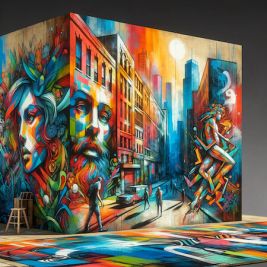
Digital and Interactive Art: Redefining User Experience in Contemporary Art
Digital and interactive art stands at the intersection of technology and creativity, offering a new frontier where art transcends traditional boundaries to become a dynamic participant in the dialogue between artist and audience. This blog post delves into how digital tools and interactive platforms are reshaping the art world, providing immersive experiences that challenge our perceptions and deepen our engagement with art.
The Essence of Digital and Interactive Art
Digital and interactive art uses technology as a core element of artistic creation and viewer engagement. This art form leverages digital technology, including augmented reality (AR), virtual reality (VR), and interactive installations, to create experiences where the viewer becomes part of the art itself.
Key Forms and Techniques
- Augmented Reality (AR) and Virtual Reality (VR): AR adds digital elements to a live view often by using the camera on a smartphone, while VR implies a complete immersion experience that shuts out the physical world. Both technologies allow artists to create layered realities that merge the digital with the physical.
- Interactive Installations: These installations respond to the presence or actions of visitors, changing based on their input. They often use sensors, motion tracking, or touch-sensitive interfaces to create a dialogue between the viewer and the artwork.
- Projection Mapping: This technique projects visual content onto physical objects, often creating the illusion of those objects moving or deforming. Projection mapping is commonly used in public art displays and multimedia performances, transforming ordinary environments into extraordinary visual experiences.
Impact on the Art World
Digital and interactive art has democratized access to art by making it more accessible to a broader audience. These artworks can be displayed online or in public spaces, allowing people from different geographical locations to experience them without visiting traditional art venues like galleries or museums.
Future Trends and Innovations
The future of digital and interactive art looks promising, with ongoing advancements in technology paving the way for even more complex and engaging artworks. AI and machine learning are beginning to influence how art is created and experienced, with algorithms capable of generating art or adapting the artwork based on viewer interactions.
Digital and interactive art is not merely a form of artistic expression but is a growing cultural phenomenon that invites us to reconsider the role of the audience in art. It encourages participation, challenges passive consumption, and makes art a more inclusive and interactive experience. As technology continues to evolve, so will the ways we interact with and perceive art, making digital and interactive art forms a critical area of growth in the contemporary art world.
How do you see digital and interactive art influencing your experience of art and culture? Share your views in the comments below, or explore more about how technology is blending with artistic expression on our social media channels.

 Renaissance is an era of great names
Renaissance is an era of great names  The most famous expressionist artists
The most famous expressionist artists  Street Art and Neo-Expressionism: Vital Art Trends of 2023
Street Art and Neo-Expressionism: Vital Art Trends of 2023  Alberto Giacometti was a great sculptor of the 20th century who relentlessly shattered the stereotypes of art in search of creative self-expression
Alberto Giacometti was a great sculptor of the 20th century who relentlessly shattered the stereotypes of art in search of creative self-expression  Ecole de Paris and other masters online auction on drouot.com, until 5 dec 2023
Ecole de Paris and other masters online auction on drouot.com, until 5 dec 2023  Fashion Photography - the Dazzling World of Fashion, Models, and Glossy Magazines
Fashion Photography - the Dazzling World of Fashion, Models, and Glossy Magazines  The painting "The Umbrellas" by Pierre-Auguste Renoir is a masterfully created illusion of black color
The painting "The Umbrellas" by Pierre-Auguste Renoir is a masterfully created illusion of black color  Etching is a type of engraving and printing technique
Etching is a type of engraving and printing technique  The painting "Dido building Carthage" by William Turner is the artist's beloved creation, which he wanted to take with him to his grave
The painting "Dido building Carthage" by William Turner is the artist's beloved creation, which he wanted to take with him to his grave  The painting "The Burning of the Houses of Lords and Commons" by William Turner is a dramatic depiction of a historical event
The painting "The Burning of the Houses of Lords and Commons" by William Turner is a dramatic depiction of a historical event